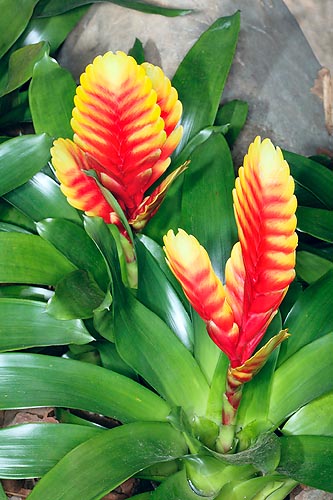Family : Bromeliaceae

Text © Pietro Puccio

English translation by Mario Beltramini

The inflorescences are formed by flat spikes © G. Mazza
The genus Vriesea Lindl. (1843) is distributed all over the Tropical America (Argentina, Belize, Bolivia, Brazil, Colombia, Costa Rica, Cuba, Dominican Republic, Ecuador, El Salvador, French Guyana, Guatemala, Guyana, Haiti, Honduras, Jamaica, Leeward Islands, Nicaragua, Panama, Paraguay, Peru, Puerto Rico, Surinam, Trinidad and Tobago, Venezuela and Windward Islands).
The genus is honoured to the Dutch botanist Willem Hendrik de Vriese (1806-1862).
The genus contains about 150 herbaceous plants, evergreen, monocarpic (bearing fruit only one time during its existence), mostly epiphytic, some of which of big size.
They are characterized for having unarmed leaves, the small ones usually green, the big ones variously coloured and covered by bands both longitudinal and transversal, mostly forming a rosette with central cavity usually full of water. The inflorescences are usually formed by a flat spike, in some cases ramified, of bracts with bright colours which remain unchanged for many months. The plants in cultivation are rather few, whilst countless are the hybrids and the varieties produced in great quantity, in particular as indoor plants. In the tropical and subtropical climates, the Vriesea are often cultivated as epiphytic on the trees, but also for covering the soil for forming flower-beds and edges; elsewhere, the numerous hybrids in particular, are utilized as indoor decoration. They require light substrata, draining, sandy, acidic or neutral, kept humid, and temperatures never under the 16°C.
Most of them need semi-shaded position and high local humidity or, as a last resource, in presence of dry air and high temperatures, very thin nebulisations are to be done, for short time, utilizing water at room temperature and not calcareous, in order not to cause anti-aestethic dots on the leaves; the plants with grey leaves require more light and less humidity. They easily reproduce by vegetative way through the new plants which come out from the leaves from axillary gemmae, which can be detached when they have reached the size of one third of the mother plant; the reproduction on wide scale for commercial purposes is done by micro-propagation.
Synonyms: Hexalepis Raf. (1838); Vrieseida Rojas Acosta (1897); Cipuropsis Ule (1907); Neovriesia Britton (1923); Alcantarea (E.Morren) Harms (1929); × Vriecantarea J.R.Grant (1996); Werauhia J.R.Grant (1995).
→ For general notions about BROMELIACEAE please click here.
